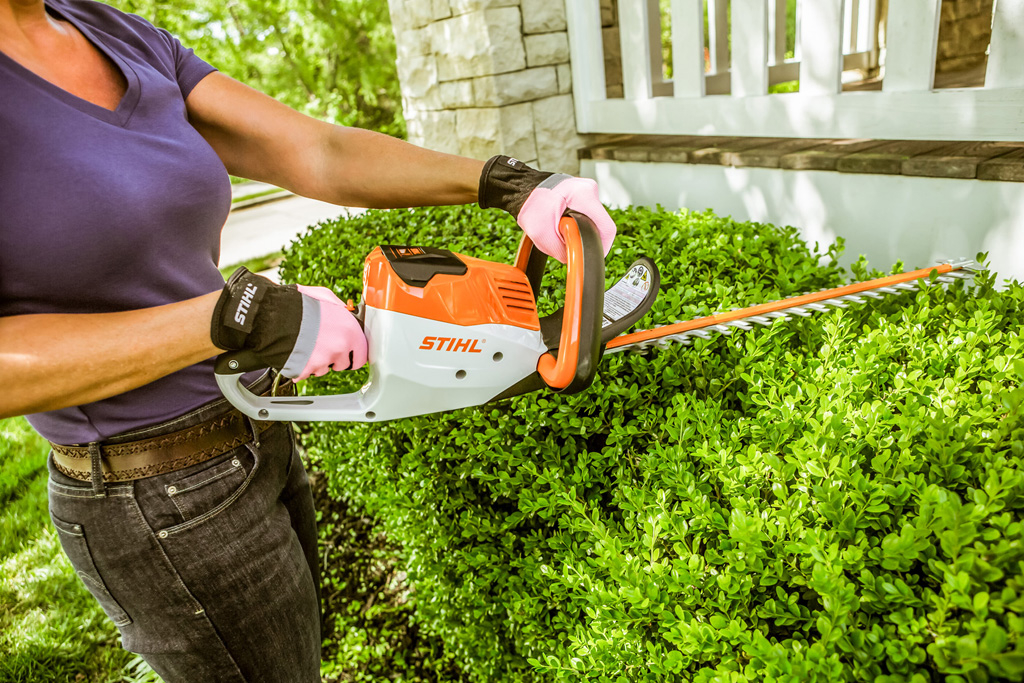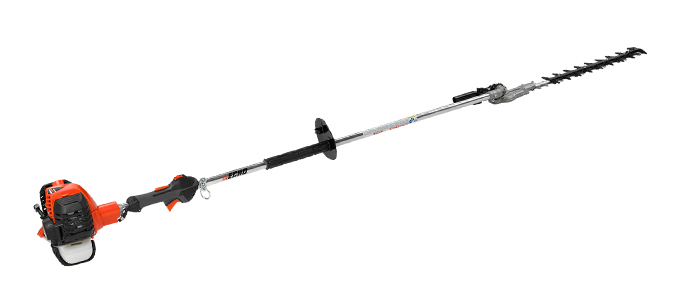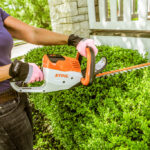How To Trim Hedges the Right Way
How To Trim Hedges the Right Way
Hedges are a popular landscaping choice, and for good reason. Attractively trimmed plants can provide living walls for privacy or to divide space in the garden. A nice hedge or topiary can also act as a focal point or backdrop for other garden plants.
Whether you’re trimming new hedges or maintaining established ones, the way you trim hedges matters to the plants’ appearance and health. To keep hedges healthy and looking good, you’ll want to use the right tools and the right techniques.

General Trimmer Maintenance
Keeping your trimmer in good working order makes it last longer and is also healthier for the hedges you're cutting. Dull trimmer blades make ragged cuts and tear foliage instead of cutting through cleanly, which doesn't look nice and can invite disease. Stihl’s Practical Knowledge article series recommends having dull hedge trimmer blades professionally sharpened, which we can do here at Richardson Saw's service department.
Sap from the hedges you're trimming will gum up the blades if it's not cleaned off, so remember to clean the cutting blades before you put the trimmers away. You’ll also want to clean off air intakes and regularly check and clean or replace air filters. For gasoline-powered equipment, drain the fuel or add a fuel stabilizer to the tank before storage. For battery-powered equipment, store batteries separate from the tool.
Trimming Tips
Trimming involves cutting the ends of branches off a plant to tidy up its appearance. It’s different than pruning, which involves cutting out branches. Some shrubs, like boxwoods, respond well if you trim them into hedges. Others, like holly, don’t grow well if pruned by hedge trimmers. Be sure to look up care tips for the specific plant you’re planning to trim to see if you should prune and/or trim it.
When trimming, cut the vertical sides of hedges first with an up-and-down sweeping motion. You’ll want to trim at a slight angle, so the bottom of the hedge is wider than the top to make sure sunlight gets to the whole hedge. Then, cut the top of the hedges. This trimming tip holds true whether you're using a standard or extended-reach trimmer, and for all heights of hedges.
Small Hedges
For mid-size and smaller hedges, you’ll typically use either hand-held clippers or a powered hedge trimmer. For most hedges, using a powered trimmer will save huge amounts of time and effort. A standard handheld hedge trimmer that’s either gasoline or battery-powered will work well for small hedges.
When cutting the tops of hedges that are chest-high or lower, hold a double-sided trimmer at a slight angle (about 10 degrees from the horizontal) and sweep back and forth to move cut leaves and branches out of the way. If you're using a one-sided hedge trimmer, you’ll only make sweeping cuts in one direction. Some styles of hedge trimmers come with or allow you to install a metal sweep on one side of the blade to cut down on clean-up time.

Large Hedges
Long-reach or extended-reach hedge trimmers make it possible to trim hedges that are taller than chest or shoulder height while keeping your feet firmly planted on the ground. Many extended-reach trimmer styles have a cutting head that swivels so you can cut the tops of hedges even if they're above head height. For example, Stihl's extended-reach trimmers have a 135-degree adjustable working blade range with 13 lockable points.
You can also use extended-reach trimmers to cut hedges that are at a lower height, but hard to reach. This includes hedges that are on the other side of a flower border or too wide to reach across with a standard hedge trimmer. Extended-reach trimmers with fixed-position cutting heads work well for these tasks.
Working With New and Old Hedges
For new hedges, start trimming early to ensure that they grow into the shape you want. Once they’re established, trim them at least two to three times a year to maintain the desired shape. For some fast-growing hedges, you may have to trim even more often.
The best time to trim depends on the type of hedge. Trim evergreens during the growing season, and make sure you stop cutting them by late summer. For deciduous hedges, you can cut them during the growing season, but if you need to prune or cut back dramatically it’s usually best to do that while the hedge is dormant.
For overgrown hedges, you’ll need to prune as well as trim. Start by removing any dead or damaged branches by cutting them back to either the base of the plant or where they join a live branch. Then, do the same for some of the overgrown branches. Step back frequently to look at the overall plant. You want to open up the inside of the plant evenly so the branches aren’t so crowded together.
Choosing the Right Tools
Tools for hedge trimming include hand-held tools including pruners, pruning saws, loppers, and hedge-trimming sheers. For some types of cutting, like trimming out specific small branches, these hand tools are the best choice. But for larger trimming jobs, it will be much easier if you use powered hedge sheers, trimmers, and extended-reach trimmers.
Click here to read our “Buying Guide: Hedge Trimmers for Shrub, Hedge, and Tree Maintenance.”
Here at Richardson Saw, we carry electric, battery, and gasoline-powered hedge trimmers from high-quality brands including STIHL, Echo, RedMax, and Shindaiwa. These include a small, hand-held powered trimmer from STIHL, a wide variety of battery-powered and gas-powered standard hedge trimmers, as well as extended-reach hedge trimmers and trimmer attachments for multitools. Browse our trimmer selection online, or stop by and see our inventory in person. We’ll be happy to answer your questions and help you find the perfect hedge trimmer for your needs.


